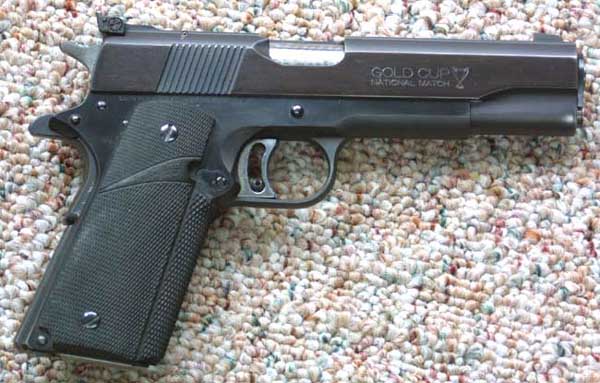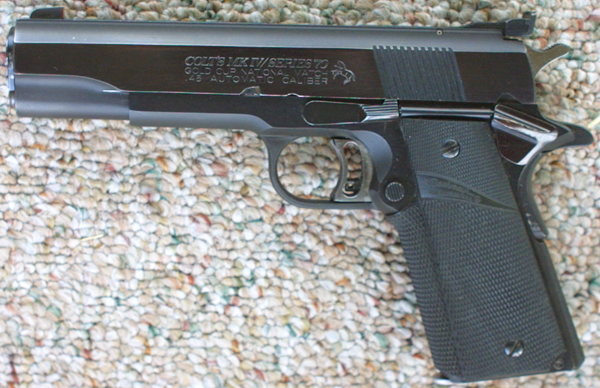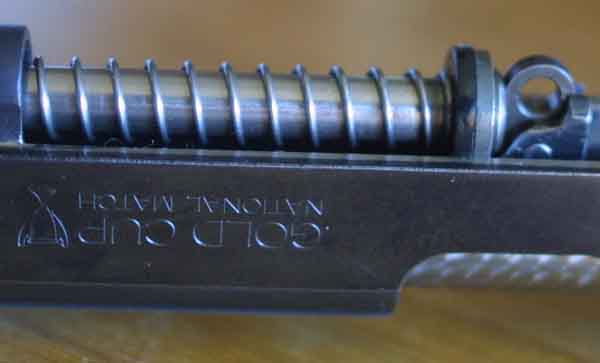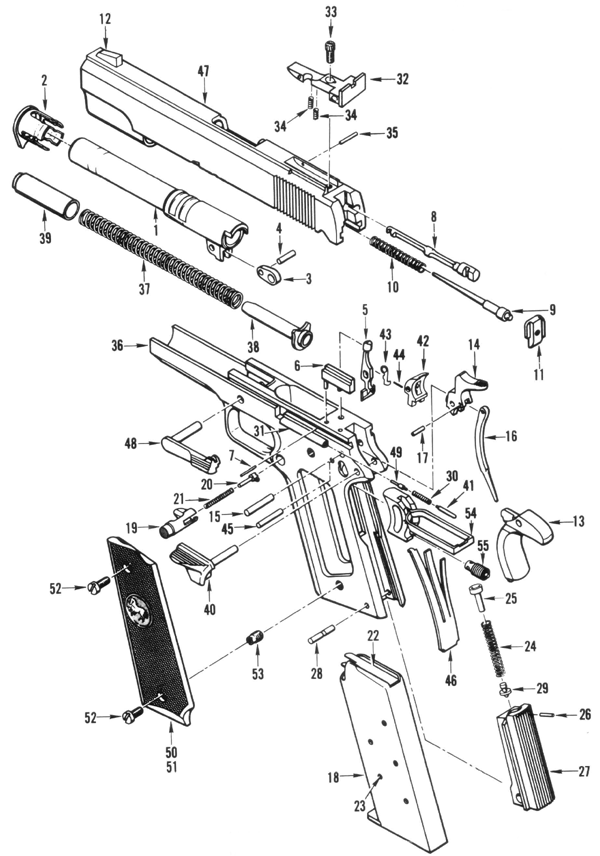 Colt Gold Cup
Colt Gold Cup
| Length overall | Barrel Length | Weight | Caliber | Action Type | Magazine Capacity |
| 8 ½ Inches | 5 Inches | 38 oz. | .45 A.C.P. | Recoil Semi | 7+1 |
With target loads, I can shoot 1 to 1 ½ inch groups with this gun. Incidentally, target loads are what should be used as the gun is very lightly sprung (10 – 11
 pounds), and will not hold up well under the constant pounding of full
loads. This gun was for years the master of the range, and still holds
it's own, although it is now being challenged from many quarters. This
is not really a service or combat gun, though with proper care it will serve
well. The same tightly dimensioned parts which mesh so closely and give
the gun it's great accuracy, choke very easily on the dirt, grime and mud
that seem to have no effect on the standard model.
pounds), and will not hold up well under the constant pounding of full
loads. This gun was for years the master of the range, and still holds
it's own, although it is now being challenged from many quarters. This
is not really a service or combat gun, though with proper care it will serve
well. The same tightly dimensioned parts which mesh so closely and give
the gun it's great accuracy, choke very easily on the dirt, grime and mud
that seem to have no effect on the standard model. This gun also needs to be kept clean and well lubricated. The old joke, or rule of thumb, was that if you picked the gun up, pointed the muzzle at the ground, and no oil dripped out, it was not properly lubricated. Times have changed, and today's lubricants are far better than anything of thirty years ago, permitting a bit less extravagant saturation. Still, the tightly dimensioned parts are a bit less forgiving than the more generous tolerances on the service gun.
This series of handguns was an answer to some of the shortcomings of the original models, when stacked up against the target revolvers of the day. The original M1911, and M1911A1 handguns were, and continue to be, superb fighting tools; but they were not perfect. This was a new design, a whole new concept, in handguns, and it would take some time for the model to reach it's full potential. In particular, the stock guns had some real problems, when being used against target revolvers in competition. Where the barrel of a revolver is set, unmoving, in the frame, that of a semi auto moves. In addition, the sights of a semi auto are mounted on a slide, which also moves. With all of these surfaces moving during firing, there is considerable latitude for the type of inconsistency that causes inaccuracy.
The only way to really fix this problem, is to greatly tighten the tolerances of the gun. This requires a level of precision which did not lend itself to turn of the century mass production. A tightly dimensioned gun also introduces problems of reduced reliability, and increased cleaning and maintenance. Even so, to make these guns even remotely competitive with the revolvers of the day, many target shooters demanded that the factory do something. This is not to say that the guns were dangerously inaccurate. An M1911, which might shoot into six inches at fifty yards, was more than good enough for a man in the trenches; but was far from satisfactory in a match, were a half an inch might be the difference between first and last place. Less than solid slide to frame fit is cured by the simple expedient of extra care taken in the factory to hand match individual slides to frames and to polish and hone their fitting.
Sloppy barrel to bushing fit, which was the cause of most of the accuracy problems with earlier solid bushing service grade Government Models, was fixed by custom fitting oversized match barrels to bushings, and slides. A permanent design fix was attempted in the Series 70 redesign, by the introduction of the collet bushing which“ grips” the specially configured barrel with spring tension “fingers” that ensure there is no slack between the barrel and the bushing at the muzzle. These were dropped with the introduction of the series 80 models, due to concern about possible breakage of the collet.
Colt began to produce hand fitted pistols
for match shooters, in 1933, calling them the Colt National Match models.
These were made until the beginning of W.W.II, when production of civilian
firearms halted, due to military priorities. These guns were outgrowths
of custom pistols which colt had been turning out, by request, for individuals
since 1919. The model went back into production, in changed form, as the
Gold Cup, in 1957. The new model had high profile, adjustable target sights
(Colt-Elliason), a wide trigger with a trigger stop, a relieved ejection
port, a flat main spring housing, and a match grade barrel. The Gold Cup
barrel has a narrower hood, than a standard barrel, and the slides are hand
fitted. On the original versions, these slides had cut outs to make them
lighter. This model was produced until it was replaced by the MKIV in 1970.
The MKIV Series 70, which is the version shown
here, was very similar to the preceding model, but had a flat milled sighting
plane, a target hammer, and no longer had the lightened slide. The new series
featured the Accurizor barrel and bushing, which used a spring steel, finger
collet. The fingers of the collet were sprung, and were designed to flex
in order to tightly grasp the end of the barrel. This was done as an
alternative to producing ever tighter tolerances in barrel/bushing units.
The tighter tolerances gave great accuracy; but they tended to make the
guns more susceptible to jamming, and made constant cleaning, and lubrication
critical to the functioning of the gun. These guns were made until 1983,
to be replaced by the Series 80. The new guns did away with the collet bushing,
and utilized a new trigger safety system.
I prefer to think of this gun as a Ferrari, very
high performing, but touchy, requiring much care. The standard .45 Government,
on the other hand, is an army jeep; a little rough around the edges, not
a great performer, compared to the Ferrari, but try taking that Ferrari
off road some day, and you will have to send the old jeep in to go and
pull it out. My gun is a series 70, which means it has been spared the lawyer
inspired firing pin safety burdening the newer series 80 guns. These series
70 guns are in a certain amount of demand, as they are no longer made,
and have a much better trigger pull than the series 80.
Though the Gold cup is mechanically the same
as the standard M1911 Government pistol, it does feature some enhancements.
Some of the ways in which it differs from the standard model are enumerated
below.
Some critics believe that this feature serves no real purpose, and only complicates disassembly of the gun for cleaning. |
|
| The ejection port on the Gold Cup is lowered
and relieved. This is a modification that competitive shooters have been
making for years. Though some claim that it may make the gun less liable
to fail to eject, the most common reason given, for it's inclusion, is
that this prevents the spent cartridges from becoming dinged or dented
as they are ejected from the pistol. This greatly increases their lives,
and eases the job of the reloader. |
|
| The trigger is wide, grooved, and adjustable
for overtravel. The overtravel adjustment is something I never quite saw
the need for, until I fired the Gold Cup. Set too loosely, there is
no advantage over a standard non adjustable trigger. Set too tightly, the
trigger will not have enough travel to release the sear Properly set, the
trigger seems hardly to move at all, and stops cleanly, and crisply
as the hammer falls. Even without the overtravel stop, the trigger is light,
smooth, and wonderful. Steady firing of a gun with such a trigger will
make most other triggers feel crude and cumbersome, and will make the rather
sloppy triggers of the double action wonder nine type pistols feel ghastly
and horrible beyond description. |
|
| Left: The Colt Ellasian rear sight is a high profile target sight, which offers an exceptionally good sight picture, and is easily and precisely adjustable. Note the gripping surface of the wide, target style, hammer, visible in this view. Below: This marvelous sight is mated to a flat, grooved sighting plane, which is tipped by a high profile front sight. |
|
| The collet bushing is designed to tightly grasp
the end of the barrel, while at the same time, having enough spring so that
a bit of dirt or grit will not cause the gun to seize up or jam. This feature
was discarded on the newer series 80 models. |
|
| After removing the magazine, and clearing
the chamber, press in on the plug which retains the recoil spring. This
plug is located directly under the muzzle. With the plug depressed, turn
the barrel bushing towards the right hand side of the pistol. Keep your
thumb positioned over the plug. |
|
| Gently ease the plug, along with the recoil
spring, out of the pistol. The recoil spring exerts something like 10 -
20 pounds of force on the plug, so you may wish to take precautions to prevent
the plug from being launched across the room. Do not completely remove the
spring. Merely allow the spring pressure top be relieved. |
|
| Push the slide back, until the cut out shown,
is lined up with the slide stop. The slide stop may then be removed, by
simply pushing it out. |
|
| The slide stop should come out easily, as
shown. You may need to start it off, by pressing it out from the other side. |
|
| Remove the slide, containing all of the top
end components, from the frame, by simply sliding it forward. |
|
| The recoil spring may now be removed by pulling
it out of the front of the slide. This is, incidentally, opposite of the
disassembly of the standard model, in which the guide rod is removed first,
before the spring. |
|
| Turning the slide upside down, will now permit
removal of the recoil spring guide, by lifting it up and out of the rear
of the slide. The recoil spring itself, should be removed first, because
the full length guide rod will not easily clear the slide, with the spring
still in place. |
|
| The barrel bushing may now be turned all the
way to the left, which will permit it's removal, and allow for the removal
of the barrel, by sliding it forward out of the muzzle end of the slide. |
|
| The barrel should now easily pull right out
of the front of the slide. If it does not, check to see that the small pivot
link is in the down position. |
|
| The Colt Gold Cup, stripped for cleaning. |
|

|
Most manuals will tell you that to reassemble,
simply perform the above steps in reverse. This is true, for the Gold Cup,exept
for one thing After the slide is assembled, make certain that the toggle
link is up, as shown. Then slide the unit onto the frame, and turn the whole
gun right side up. This will allow the toggle to hang down, making it easier
to fit the slide stop through. In addition, there is a spring loaded pin
which holds the slide stop in place. You may use a small screw driver
to gently nudge it over, when fitting the slide stop. |
